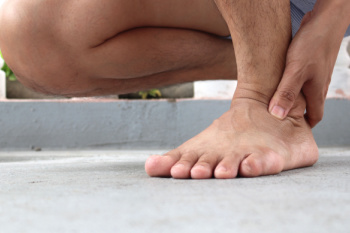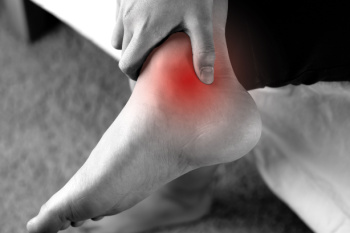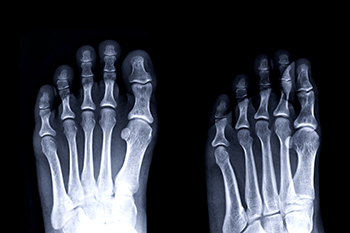Flint Office
1303 S. Linden Rd., Suite D
Flint, MI 48532

Peripheral neuropathy occurs when nerves outside the brain and spinal cord become damaged, disrupting signals between the brain, spinal cord, and the rest of the body. This can lead to numbness, tingling, burning, or weakness, often starting in the feet. Causes vary but include diabetes, infections, vitamin deficiencies, and prolonged pressure on nerves. People with neuropathy may struggle with balance, coordination, and even simple tasks like walking or sensing temperature changes. Over time, nerve damage can worsen, leading to foot injuries or ulcers that may go unnoticed due to reduced sensation. Treatment focuses on managing the underlying cause, relieving symptoms, and preventing complications. Medications, lifestyle changes, and targeted exercises can help improve nerve function. Proper foot care is essential to avoid further injury. If you are experiencing unexplained foot pain, numbness, or weakness, it is suggested that you see a podiatrist for evaluation and appropriate care.
Neuropathy
Neuropathy can be a potentially serious condition, especially if it is left undiagnosed. If you have any concerns that you may be experiencing nerve loss in your feet, consult with one of our podiatrists from Community Podiatry Group. Our doctors will assess your condition and provide you with quality foot and ankle treatment for neuropathy.
What Is Neuropathy?
Neuropathy is a condition that leads to damage to the nerves in the body. Peripheral neuropathy, or neuropathy that affects your peripheral nervous system, usually occurs in the feet. Neuropathy can be triggered by a number of different causes. Such causes include diabetes, infections, cancers, disorders, and toxic substances.
Symptoms of Neuropathy Include:
Those with diabetes are at serious risk due to being unable to feel an ulcer on their feet. Diabetics usually also suffer from poor blood circulation. This can lead to the wound not healing, infections occurring, and the limb may have to be amputated.
Treatment
To treat neuropathy in the foot, podiatrists will first diagnose the cause of the neuropathy. Figuring out the underlying cause of the neuropathy will allow the podiatrist to prescribe the best treatment, whether it be caused by diabetes, toxic substance exposure, infection, etc. If the nerve has not died, then it’s possible that sensation may be able to return to the foot.
Pain medication may be issued for pain. Electrical nerve stimulation can be used to stimulate nerves. If the neuropathy is caused from pressure on the nerves, then surgery may be necessary.
If you have any questions, please feel free to contact our office located in Flint, MI . We offer the newest diagnostic and treatment technologies for all your foot care needs.

Tarsal tunnel syndrome is caused by the compression of the posterior tibial nerve as it passes through the tarsal tunnel, located on the inside of the ankle. This compression can lead to various symptoms such as numbness, tingling, burning sensations, and sharp pain in the foot and ankle area. These symptoms often worsen with prolonged standing, walking, or activity. The causes of tarsal tunnel syndrome include trauma, repetitive stress, or conditions like diabetes that lead to nerve damage. Other contributing factors include swelling, cysts, or flat feet, which can narrow the tunnel and put pressure on the nerve. To diagnose tarsal tunnel syndrome, podiatrists rely on a thorough physical examination and may use imaging tests like MRI scans or ultrasounds to assess the area. Nerve conduction studies may also be performed to measure the electrical activity of the nerves and confirm the diagnosis. If you are experiencing any of the above symptoms, it is suggested that you confer with a podiatrist who can provide an accurate diagnosis and treatment.
Tarsal tunnel syndrome can be very uncomfortable to live with. If you are experiencing tarsal tunnel syndrome, contact one of our podiatrists of Community Podiatry Group. Our doctors can provide the care you need to keep you pain-free and on your feet.
Tarsal Tunnel Syndrome
Tarsal tunnel syndrome, which can also be called tibial nerve dysfunction, is an uncommon condition of misfiring peripheral nerves in the foot. The tibial nerve is the peripheral nerve in the leg responsible for sensation and movement of the foot and calf muscles. In tarsal tunnel syndrome, the tibial nerve is damaged, causing problems with movement and feeling in the foot of the affected leg.
Common Cause of Tarsal Tunnel Syndrome
The Effects of Tarsal Tunnel Syndrome
A physical exam of the leg can help identify the presence of tarsal tunnel syndrome. Medical tests, such as a nerve biopsy, are also used to diagnose the condition. Patients may receive physical therapy and prescriptive medication. In extreme cases, some may require surgery.
If you have any questions please feel free to contact our office located in Flint, MI . We offer the newest diagnostic and treatment technologies for all your foot and ankle needs.

Running is an excellent form of exercise, but it can lead to various foot conditions if proper care is not taken. Common foot problems such as blisters, plantar fasciitis, and stress fractures can arise from wearing improper footwear, poor running techniques, or lack of foot care. One of the most effective ways to prevent these issues is by choosing the right pair of running shoes that offer proper arch support, cushioning, and a good fit. Regularly replacing worn-out shoes ensures continued support. It is also important to gradually increase running distances to avoid overuse injuries. Stretching before and after runs can help maintain flexibility and prevent muscle strain. Keeping feet dry and using moisture-wicking socks can reduce the risk of blisters and fungal infections. If you have developed foot conditions from running, it is suggested that you consult a podiatrist who can offer you effective relief and treatment methods.
All runners should take extra precaution when trying to avoid injury. If you have any concerns about your feet, contact one of our podiatrists of Community Podiatry Group. Our doctors will treat your foot and ankle needs.
How to Prevent Running Injuries
There are a lot of mistakes a runner can make prior to a workout that can induce injury. A lot of athletes tend to overstretch before running, instead of saving those workouts for a post-run routine. Deep lunges and hand-to-toe hamstring pulls should be performed after a workout instead of during a warmup. Another common mistake is jumping into an intense routine before your body is physically prepared for it. You should try to ease your way into long-distance running instead of forcing yourself to rush into it.
More Tips for Preventing Injury
If you have any questions, please feel free to contact our office located in Flint, MI . We offer the newest diagnostic and treatment technologies for all your foot care needs.

The foot is often overlooked in discussions about overall body health, but it plays a critical role in maintaining balance and supporting movement. As the foundation of your posture and stability, the foot must be mobile and adaptable to function properly. Good foot mobility allows for proper alignment and efficient transfer of force from the ground to the rest of the body. When the foot has the ability to adjust to different surfaces and conditions, it helps maintain balance, reducing the risk of falls and injury. Many people experience limited foot mobility due to tight muscles, poor posture, or insufficient movement, which can affect overall mobility and stability. Prioritizing foot health through exercises that improve flexibility, strength, and adaptability can significantly enhance posture, prevent discomfort, and promote better balance. If you have foot pain or concerns, it is suggested that you contact a podiatrist who can treat various foot conditions, and guide you on strengthening exercises to improve balance.
If you have any concerns about your feet, contact one of our podiatrists from Community Podiatry Group. Our doctors can provide the care you need to keep you pain-free and on your feet.
Biomechanics in Podiatry
Podiatric biomechanics is a particular sector of specialty podiatry with licensed practitioners who are trained to diagnose and treat conditions affecting the foot, ankle and lower leg. Biomechanics deals with the forces that act against the body, causing an interference with the biological structures. It focuses on the movement of the ankle, the foot and the forces that interact with them.
A History of Biomechanics
Modern technological improvements are based on past theories and therapeutic processes that provide a better understanding of podiatric concepts for biomechanics. Computers can provide accurate information about the forces and patterns of the feet and lower legs.
Understanding biomechanics of the feet can help improve and eliminate pain, stopping further stress to the foot.
If you have any questions please feel free to contact our office located in Flint, MI . We offer the newest diagnostic and treatment technologies for all your foot and ankle needs.